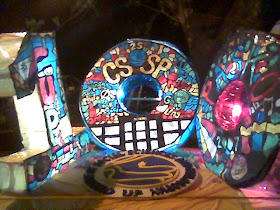In a multi-cultural society such as we live in, we encounter different celebrations, symbolisms and customs in the month of December. There are those who enthusiastically celebrate Christmas, Hanukkah, the winter holidays and those who do not believe in celebrating anything at all. As Filipinos, we have learned to be recognizant of this fact but at the same time, cling to our memories and experience of a Filipino christmas.
A most distinct symbol of a Filipino Christmas, among others, is the Christmas lantern or what is most widely known as the “parol”. The parol is so iconic that some of us would remember having this as one of our school projects in elementary, made with bamboo sticks and Japanese paper. Today, there are a variety of designs, shapes and sizes - utilizing: indigenous materials like capiz shells, straw, wood; modern materials like fiber glass, metal; psychedelic lights and music. But what is constant in the design is the five-pointed star.
The parol is derived from the Spanish word “farol”, for lantern. It is an image of the star of
Bethlehem, the guiding light of the Three Kings to the manger and metaphorically, a symbol of hope and joy for the yuletide season. It is believed that the original design was crafted by Francisco Estanislao in 1928. This lantern was used by rural folk to light their paths for the dawn masses.
The creativity and ingenuity embedded in the parol design and production, has given rise to
competitions whether in the school, community and national levels, and with some Filipino
communities in other countries. Two such events in the Philippines that I have had the pleasure of witnessing are: the Giant Lantern Festival in Pampanga and the Lantern Parade of the University of the Philippines, Diliman.
 The Pampanga Giant Lantern Festival is a competition of giant parols that are about 40 feet circumference, with lights that are programmed to music. A lantern would approximately weigh at least 1000kg and would have a minimum of 50 people working on it an entire year. The months of January to May are often devoted to laying out the electrical framework, June to July for the electrical wiring and August to December for papering and accessorizing. Then once the competition is done, itʼs back to the drawing board for next yearʼs concept and design. Each lantern would require a generator that is powerful enough to light a barrio. This visual display of lanterns are akin to the famous fountain choreography of the Bellagio in Las Vegas.
The Pampanga Giant Lantern Festival is a competition of giant parols that are about 40 feet circumference, with lights that are programmed to music. A lantern would approximately weigh at least 1000kg and would have a minimum of 50 people working on it an entire year. The months of January to May are often devoted to laying out the electrical framework, June to July for the electrical wiring and August to December for papering and accessorizing. Then once the competition is done, itʼs back to the drawing board for next yearʼs concept and design. Each lantern would require a generator that is powerful enough to light a barrio. This visual display of lanterns are akin to the famous fountain choreography of the Bellagio in Las Vegas.The festival is sponsored by business and private organizations, which enables the city
government to provide a subsidy to the participating barangays. Participants come from San Jose, Dolores, Lourdes, Sto. Rosario, Del Pilar, San Pedro, Sto. Niño, Sta. Lucia, San Nicolas and San Fernando. The lanterns are judged on the basis of design, color combination, interplay of lights and rhythm to the music.
The University of the Philippines Lantern Parade is also a visual spectacle, marked with a
social consciousness thematic approach, showcasing the critical thinking and ingenuity of the ʻskolars ng bayanʼ. The first Lantern Parade was in 1922 when the UP community used
lanterns to light their way to the church for the Christmas midnight mass. It was then
institutionalized as a university event in 1934 by University President Jorge Bocobo.
It is a parade of large lantern/floats around the university oval, taking place on the last day of classes before the Christmas holiday, and after a couple of hours of the popular Oblation Run. The floats feature the diverse causes of the different colleges of the university like government corruption, LGBT equality, foreign dominance, and other political issues. Aside from the lantern, there are also presentations in key stops for the judges. Cash prizes are allotted for those judged as Overall Best Lantern Grand Prize, Judges Choice and Most Resourceful Awards. This parade likewise attract thousands of people in the city and is normally a media event.
These use of the parol as a holiday decoration, treat and event is a tradition that marks the
Filipinosʼ creativity, ingenuity and conviction. Whatever your tradition or reminiscences are for this holiday season, I wish everyone a joyous and prosperous season!
* This article was written and published for the December 2012 issue of Pinoy Living.





No comments:
Post a Comment